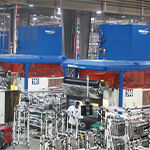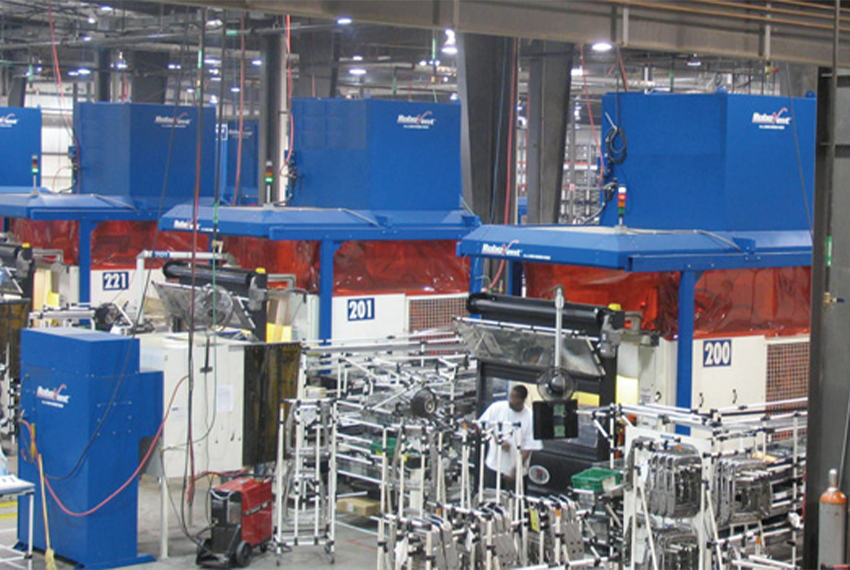Romech: Protecting Workers with Cleaner Air
Featured Solution: Senturion
Industries: Automotive
Applications: Robotic Welding
Romech is a division of Intier Automotive Seating Systems of America, Inc., under Magna International which is an industry leader in the development and manufacture of innovative vehicle systems and components for the global automotive industry.
Romech has approximately 500 employees in its manufacturing plant in Red Oak, Iowa, with annual sales of $70 million. Romech specializes in manufacturing seat frame mechanisms, such as the Chrysler Stow ‘n Go seats with 430,000-500,000 seats being produced annually. Romech also manufactures seat mechanisms for Ford and General Motors.

Romech has approximately 500 employees in its manufacturing plant in Red Oak, Iowa, with annual sales of $70 million. Romech specializes in manufacturing seat frame mechanisms, such as the Chrysler Stow ‘n Go seats with 430,000-500,000 seats being produced annually. Romech also manufactures seat mechanisms for Ford and General Motors.
With industry standards for environmental compliance (ISO 14001) and employee concern for a healthier working environment, as well as an immediate need to quell plant fires, investing in a more cost and performance-effective air-filtration system became a priority.
Doug Stoehr, maintenance manager of the Romech facility, was responsible for finding an efficient system for addressing the growing concerns voiced by management and staff about air quality in the work place. Stoehr chose the RoboVent self-contained air filtration system, manufactured by RoboVent Product Group of Clawson, Michigan, that cleans and recycles contaminated air generated in robotic welding cells.
“Before the installation of RoboVent air filtration systems, we had a great deal of difficulty in effective smoke filtration and prevention of filter fires. Obviously, we want to eliminate our employees' exposure to the hazards of smoke inhalation and potential fires,” Stoehr says.
Stoehr did a cost and performance comparison on similar air filtration products on the market and decided to use the RoboVent Self Contained FloorSaver System because of its guarantee to virtually eliminate the risk of fire and haze produced by inefficient filtration systems.
“The smoke from the welding process created a haze which created the appearance of an unsafe working environment, as well as problems with particulates in the air and a film-buildup on our equipment,” he says. “The polluted air and the coated equipment did not help create a better working environment and might affect our employee's health. It was a solution to effectively reduce, if not eliminate filter fires and outside exhaust practices. RoboVent not only cleared our facility of the haze and fire outbreaks, but raised employee expectations in terms of air quality.”
The RoboVent FloorSaver air-filtration system mounts directly on top of the welding cell, uses no ductwork and can be moved with the cell. This patented system, exclusive to RoboVent, captures all welding smoke and fumes, then filters and cleans the air, and returns clean air to the plant.
“Because of the type of work we do, robotic welding systems are a necessity,” said Stoehr. “The other products we evaluated for reducing smoke and fires from the robotic cells weren't very promising in terms of their guarantees. RoboVent had no reported fires with units over the robotic cells; no other company had those types of guarantees.”
Stoehr strongly recommends putting an air filtration system in place for companies that have robotic systems and adds that RoboVent is very capable in determining the equipment requirements needed for the application based on weld time, wire usage and type of materials used.
Stoehr mentions that although Romech regularly performs air quality testing that consistently meets OSHA air quality standards, air quality readings did improve after the air filtration system installation and there was no longer a noticeable haze in the air. He says that the air filtration systems have raised the standard in terms of air quality.
The air filtration system's enclosed system captures exhaust and contaminated air at the source and removes airborne containments before they can settle on floors, walls or in employees' lungs. It filters impurities and returns clean air to the workplace.
According to Stoehr, an additional benefit of the RoboVent filtration was the service and maintenance support program offered by RoboVent Product Group. “Ninety percent of the installation performed, was done without interfering with our the production schedule,” he said. “Monthly cleaning and inspection is provided by RoboVent Product Group.” Stoehr adds that because the RoboVent unit is so simple to use, very little training was necessary.
RoboVent dedicates one filtration unit to each weld cell, which in turn distributes the job of cleaning the air and allows for extra ventilation. This eliminates the possibility of total system failure and greatly reduces production delays and downtime during maintenance. It greatly increases flexibility within the plant, allowing for the individual cells to be moved around independently for plant configurations.
Because of the new air-filtration system, Romech has not only met but exceeded regulations on air emissions and EPA requirements.
“The key features of the RoboVent system are the conservation of floor-space, the effective method of drawing smoke away from the point of operation and the low-risk of filter fires,” Stoehr says.
Overall, Stoehr says that there are fewer complaints about weld smoke and ventilation in the plant. Stoehr concludes that an effective air filtration system allows for a safer, cleaner and more aesthetically pleasing working environment.






